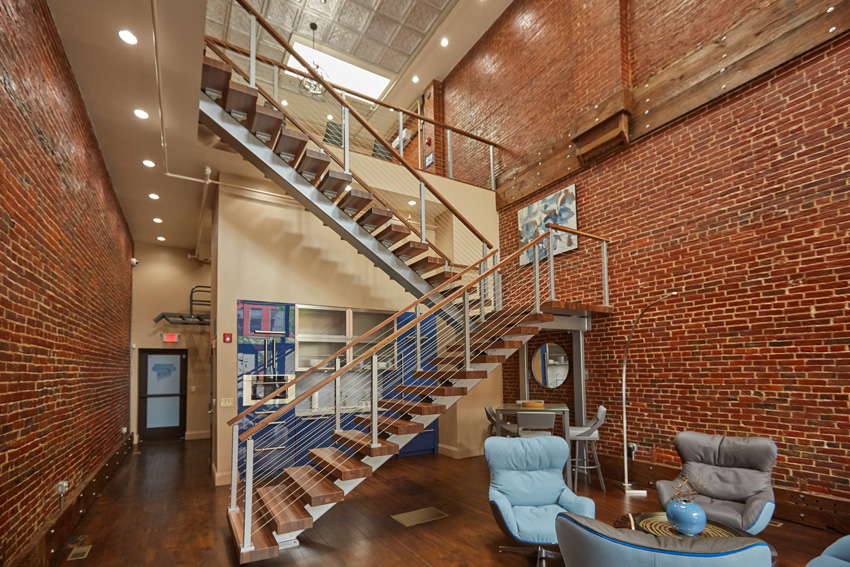The Beautiful, Modern, Budget-Friendly Floating Staircase
Floating Stair Configurations
Floating staircases are available in several configurations, giving designers options for incorporating these modern elements in a way that best suits the layout of the space and the floor-to-floor height of the project. Currently, floating staircases are commonly offered in straight, L-shaped, and switchback forms. Custom projects can also be explored for spaces with unique demands.
Straight Staircase
A straight staircase describes a staircase with the simplest silhouette. It runs from the bottom to the top in one straight slope on top of one mono stringer. This type of staircase does not change direction, and no additional intermediate supports are required to further prop it up. If the overall vertical height of the staircase is less than 12 feet, then no landing is required.
L-Shaped or 90-Degree Staircase
An L-shaped staircase describes a straight stair with a bend in it. This type of stair is also referred to as a 90-degree staircase or, less commonly, a quarter-turn stair. The staircase can turn either to the left or the right, and the change in direction is typically accomplished by incorporating a landing at the point of transition. The landing can be positioned in the middle of the staircase so that both flights of stairs are the same length, or the landing can be located closer to the bottom or the top of the stairs. When the landing is closer to the bottom or the top, this configuration is sometimes referred to as a long L-stair.
Switchback Staircase
A switchback staircase, also referred to as U-shaped stairs or half-turn stairs, is the most compact staircase design option. A person climbs the first flight of stairs, arrives at the landing, and turns 180 degrees to climb the second flight of stairs. This double-back shape allows designers to achieve the greatest heights in the smallest footprint. Floating stairs in a switchback configuration can be wall-mounted on the perimeter of the room, or they can be positioned as a centerpiece in a space with their stand-alone, steel-column-supported platforms.
Choosing a Floating Stair Provider
Once an architect has identified that a floating staircase should be incorporated into a project, there are two types of providers that the designer can work with to get the staircase designed, produced, and delivered to the project. The general contractor, or a sub-contractor, will typically be responsible for the installation of the staircase at the job site. Architects can choose to work with a local metal fabricator to design and produce the staircase, or they can choose a solution from a company that engineers floating stair systems. This choice has significant implications on the design process, as well as the production and installation timelines, and, ultimately, the overall cost of the staircase.
While a local metal fabricator certainly can deliver a beautiful floating staircase, there are many limitations that can dramatically slow the design and fabrication of the product when this type of provider is used. In addition, the installation of staircases provided by a local metal fabricator can be complex and involved. When sourced locally, it is typical for some welding to be done on-site, which can be virtually impossible in a remodeling project and awkward in new construction, depending upon when the installation of the staircase takes place. It can easily take days or weeks to configure and create a floating stairway on-site with a local metal fabricator. The crux of the issue is that a local metal fabricator will approach every project as if it is a custom and unique job because, in fact, it is. This means that each design starts from scratch. The stringer, brackets, treads, and railing system are built specifically for this one client, this one job.
Benefits of Working with a Floating Stair Company
Companies that engineer floating stair systems have streamlined the design, development, and delivery of these modern staircases so that designers can receive beautiful, code-compliant products quickly. They have experienced staff and catalogues of job examples to reference when helping a designer select the best floating staircase for a project. These companies have eliminated the guesswork and potential errors from the design process and tweaked the components and manufacturing processes so that everything fits together as it should, every time.
Beyond getting a beautiful, high-quality product more quickly, these companies can deliver the staircase in a way that makes it much faster and easier for the contractor to install. In many cases, contractors can complete the installation in one day with a crew of three carpenters. No special skills are required, and the installation can occur during the rough-in or the finished stage of the new construction or remodeling project.
When working with a company that engineers floating staircases, ease of installation is a critical part of the whole package. The company has spent time and money to develop a process and the supporting materials that general contractors everywhere can use to easily and successfully install their floating staircases. When working with a local metal fabricator, the process and delivery is oftentimes more piecemeal, and the installation can be less organized and a little more haphazard because the delivery process has not been fine-tuned or standardized.










